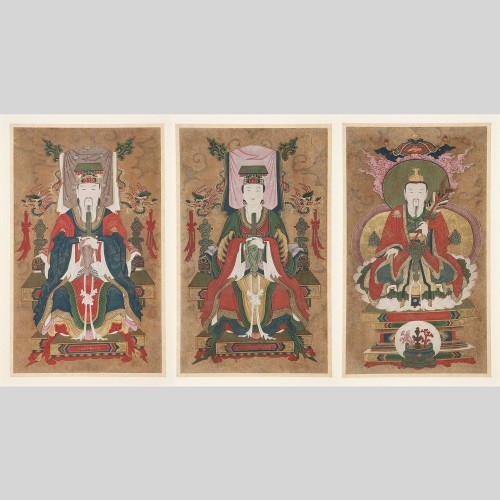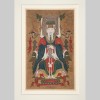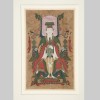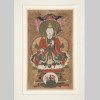본문
시왕도(十王圖)는 저승에서 망자의 죄업을 심판하는 열 명의 왕과 지옥 형벌 장면을 묘사한 불화(佛畫)입니다.
시왕은 진광왕(秦廣王), 초강왕(初江王), 송제왕(宋帝王), 오관왕(五官王), 염라왕(閻羅王), 변성왕(變成王), 태산왕(太山王), 평등왕(平等王), 도시왕(都市王), 전륜왕(轉輪王)까지 총 열명으로, 망자는 사후 49일 동안 차례로 시왕의 재판을 받습니다. 시왕 신앙은 윤회사상과 도교의 명부 신앙이 융합되어 형성되었으며, 예수시왕생칠경(預修十王生七經)에 따라 교리적으로 체계화되었습니다.
한국에서는 통일신라 시대에 전래되어 고려와 조선을 거치며 명부전과 관련 불화의 주요 도상으로 확립됩니다. 특히 지장보살과 결합된 지장시왕도 형식은 민간의 내세관과 공포를 시각적으로 형상화하며 널리 유포되었습니다.
왕마다 주재하는 지옥과 고유의 형벌 장면이 등장하고, 권속(眷屬)들의 세부 묘사를 통해 당대의 사회상과 신앙 세계를 엿볼 수 있습니다. 화면 형식은 열 폭부터 두 폭까지 다양하며 대체로 왕마다 한 폭씩 그려지는 형식을 따릅니다. 또한 사찰과 발원자에 따라 구성과 규모가 달라집니다.
대표작으로는 해인사, 옥천사, 통도사의 시왕도가 있으며, 전통적 도상과 화풍의 흐름을 보여주는 중요한 사례들입니다.
━━━━━
《十王图》是描绘阴间中掌管亡者罪业审判的十位冥王,以及地狱刑罚场景的佛教绘画作品。
所谓“十王”,包括秦广王、初江王、宋帝王、五官王、阎罗王、变成王、泰山王、平等王、都市王与转轮王共十位,亡者在去世后的49天内依次接受十王的审判。十王信仰是融合了轮回思想与道教冥府神信仰的产物,并根据《预修十王生七经》形成系统化教义。
在韩国,此信仰自统一新罗时期传入,经过高丽与朝鲜时期,逐渐确立为冥府殿堂及相关佛画的主要题材。特别是与地藏菩萨结合的“地藏十王图”形式,将民间对来世与死亡的恐惧视觉化、具象化,广为流传。
画中每位冥王掌管不同的地狱与对应的刑罚场景,通过对眷属与刑罚细节的描绘,可窥见当时社会风貌与信仰世界的样貌。画面形式多样,从十幅连屏至二联式不等,通常采用一王一画面的方式绘制。此外,根据寺院或发愿者的不同,画面结构与规模亦有所差异。
代表性作品包括海印寺、玉泉寺、通度寺所藏的《十王图》,是展现传统图像体系与绘画风格演变的重要实例。
━━━━━
The Siwangdo (Painting of the Ten Kings) is a Buddhist painting depicting the ten kings who judge the souls of the dead in the afterlife, along with scenes of hellish punishment.
The ten kings—Qinguang Wang, Chujiang Wang, Songdi Wang, Wuguan Wang, Yama Wang, Biansheng Wang, Taishan Wang, Pingdeng Wang, Dushi Wang, and Zhuanlun Wang—judge the deceased in sequential trials over 49 days after death. The Ten Kings belief system combines the Buddhist concept of reincarnation with Taoist netherworld beliefs and was systematized through texts like the Yusip Siwang Saengchilgyeong.
Introduced to Korea during the Unified Silla period, this theme became prominent in paintings and temple halls dedicated to the underworld throughout the Goryeo and Joseon periods. Particularly widespread were depictions combining the Bodhisattva Kṣitigarbha (Jijang Bosal) with the Ten Kings, visually expressing popular beliefs and fears about the afterlife.
Each king is associated with a specific realm of hell and its punishments, and detailed portrayals of their retainers reveal aspects of contemporary society and religious beliefs. The format of these paintings varies from ten-panel compositions to more compact formats, typically assigning one king per panel. The composition and scale differ depending on the temple and the patron.
Representative works can be found at Haeinsa, Okcheonsa, and Tongdosa, serving as key examples of the iconography and painting styles of the time.




